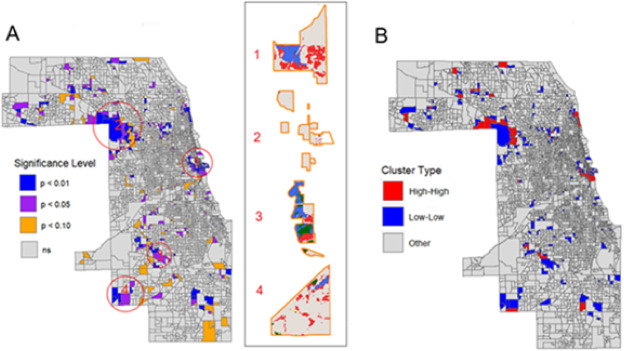Characteristics of blue and green spaces within and beyond highrisk suicide clusters

The land cover paradox
This paper explores associations between blue- and green- space and suicide mortality in Cook County, Illinois
| Short description: | The land cover paradox: Characteristics of blue- and green spaces within and beyond high-risk suicide clusters - ScienceDirect | |
| Lead developer: | Dr. Gia Elise Barboza-Salerno | |
| Further reading: | Please read the paper published in SSM Population Health | |
| Download: | Github repo | |
| Main data source(s): | MLCD land cover, tree- and park- equity | |
| Coverage: | Cook County, IL | |
| Citation: | @article{BARBOZA2025101820, title = {The Land Cover Paradox: {{Characteristics}} of Blue- and Green Spaces within and beyond High-Risk Suicide Clusters}, author = {Barboza, Gia E. and {Watson-Grace}, Amy and {Shockley-McCarthy}, Karla and Harrington, Taylor and Warren, Keith and Steelsmith, Danielle}, year = {2025}, journal = {SSM - Population Health}, pages = {101820}, issn = {2352-8273}, doi = {10.1016/j.ssmph.2025.101820}} |
Purpose Urban suicide rates are rising, with disproportionate impacts on communities of color. While social determinants of suicide are well-established, the role of overlapping social, natural, and built environments remains underexamined.
Methods We integrated National Land Cover Database (NLCD) data on developed open space, tree canopy, blue space, and a novel measure of land cover diversity with indicators of tree and park equity, built environment features, and socioeconomic vulnerability. Bayesian spatial Poisson models were used to estimate associations between these socioenvironmental variables and suicide risk at the Census Block Group (CBG) level in Chicago. We also identified and compared spatial clusters of high and low suicide risk using Local Moran’s I.
Results Blue space and developed, open spaces were associated with reduced suicide risk, with estimated decreases of 17.9
Conclusions The findings reveal that the mental health impacts of environmental features are context-dependent and spatially patterned. While access to green and blue space may offer protective effects, these benefits are not uniformly experienced across urban neighborhoods. Suicide prevention efforts should consider not only individual and socioeconomic risk factors, but also spatial disparities in environmental quality and neighborhood-level disadvantage.
Check out this Access our tutorial on na here for more details.